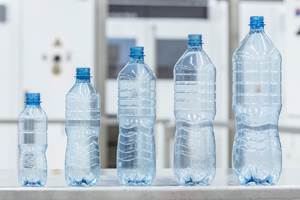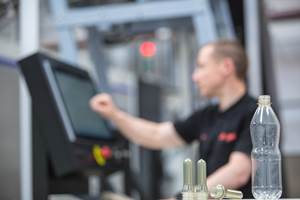The Importance of Air Valves In Accumulator-Head Blow Molding
Blow Molding Know How
Proper air usage is an important part of making good blow molded parts.
Very little is asked about the number, size, and functions of air valves for accumulator-head blow molding machines. Usually, the number of valves ordered is many fewer than may be required for all of the parts to be made. Compressed air has become very expensive. Have you walked through a blow molding facility? Can you hear the hissing air leaks? This is good money going down the drain and taking away from your bottom line.
Proper air usage is an important part of making good blow molded parts. All types of parts that may be molded on a given machine must be considered to ensure that all bases are touched. The air supply pressure must be constant for every molding cycle. It is important to have enough air valves available on the machine. This also requires that the sequence be programmed to handle these additional valves.
In addition, the Cv (flow-capacity coefficient) and capacity of the main air blow must be sufficient to produce the part. Air must rapidly inflate the parison upon mold closing. Air must also be quickly discharged from the finished part before mold opening, vented with quick-exhaust valves near the air exhaust location.
WHERE AIR VALVES ARE USED
Typical main air-blow valves are 1¼ in. with a Cv of 31.9. The small auxiliary-function valves are 3/8 in. with a Cv of 2.4.
Low initial blowing-air pressure (around 40 psi) into the parison upon mold closing will help the parison flow around deep-draw areas. A typical initial blow ratio is up to 1.5:1. Any higher ratio will result in a part with thin walls or even a wall blow-out. The air can then be switched to higher final blowing pressure such as 100 psi for final forming of the part. This will help to minimize occurrence of thin-wall areas. The appropriate pressure sequence must be determined during initial tryout.
Pre-blowing the parison must be used with top or bottom pre-pinch mechanisms and needle blowing. Pre-blow inflation of the parison will aid insertion of the needles at various mold locations. An air cylinder is used for needle entry and the main air blow.
Top blow may require a retractable blow pin so that it can be raised up and out of the mold to allow for automatic part removal.
The air cylinder for main air blow may be used to form the part neck opening. This is normally mounted on the bottom of the press.
Other applications for air valves on the press include the following:
•Stripper mechanism to discharge the part from the mold.
•Press gates for automatic operation. They normally use two air cylinders, one for each gate door.
•Knockout (cutters) mounted in mold to pierce the finished part.
•Dual parison-spreader systems to spread the parison in a horizontal direction. These are usually used with bottom blow pins that are offset on parts. This will require two air cylinders for horizontal movement and also two air cylinders for up and down movements of the spreader pins. These pins ensure a very consistent parison width on cycle after cycle. They also help get better control of wall thickness across the width of the parison.
•Pneumatic shutoff on the hopper slide gate.
•Automatic lubrication system. This uses air for cycling delivery of grease to the various lubrication stations.
•Part ejectors mounted inside molds to release blown parts. These are actuated by air valves and cylinders. The number of cylinders/valves required will depend upon the mold and part design.
•Core slides in the molds. The core slides must be moved at the proper time and could require sensors detect their position. The slides may be moved by either air or hydraulics.
Dual-head operation usually doubles the number of air valves required. Air storage (surge) tanks rated at 250 gal capacity on the machine will ensure surge-free air pressure during the operating sequence, which will help make consistent parts.
Some systems are provided with as many as 32 air valves. Make sure the relay logic diagram is properly programmed to handle these functions. No matter what number of air valves are used, each can be programmed for the valve description (name), the function needed, and when to turn it on or off. You can do the same thing for the trigger device for an air valve.
Preprogrammed valve actuation sequences for specific parts can be selected instantly via a touchscreen controller. The following items can be predesigned as needed into a sequence program for the end of blow time:
•Mold decompression.
•Clamp closing position.
•Clamp opening position.
•Accumulator shooting position.
•Accumulator filling position.
•Start blow time.
•End of blow time
•After air valve
•After hydraulic valve
After the end of vent time, the system can include ejection systems, core slides, other user-defined items, and perhaps a position limit switch. All these items can be preprogrammed into the system for future use, so there will be no need to wait for the machine supplier to add them when a new job requires them. That also eliminates the time and expense for the supplier to send a technician to your plant to do the programming. Valve sequence programming now can even be done online via a modem hookup directly to your machine.
Some progress has been made in using proportional air valves for special requirements where you might want to vary the air-flow volume and pressure on some functions during different parts of the cycle. A good example would be a pre-pinch operation where you will want to change the flow and pressure during inflation of the parison.
Air discharge must reduce pressure in the part before the molds open. This is set up as a safety system to prevent the finished part from blowing out due to excessive internal air pressure.
There is a blow/cool method called “huff and puff.” This allows the hot air to be purged from the part and cool air to be blown again inside the part. In some cases, this decreased the cooling cycle time by as much as 10 to 15 sec.
About the Author
Robert Slawska has more than 45 years’ experience in blow molding. His firm, Proven Technology Inc., Hillsborough, N.J., provides engineering/consulting services and equipment to industrial blow molders. Reach him at (908) 359-7888 or email rslawska@aol.com. Website: www.industrialblowmolding.com
Related Content
First Water Bottles With Ultrathin Glass Coating
Long used for sensitive juices and carbonated soft drinks, KHS Freshsafe PET Plasmax vapor-deposited glass coating is now providing freshness and flavor protection for PET mineral water bottles.
Read MoreFor Extrusion and Injection-Blow Molders, Numerous Upgrades in Machines and Services
Uniloy is revising its machinery lines across the board and strengthening after-sales services in tooling maintenance, spare parts and tech service.
Read MoreServices to Help Blow Molders Convert to rPET
Sidel launches “RePETable” range of services as “one-stop” solution to efficient adoption of rPET for bottle production.
Read MoreAll-Electric Shuttle and Stretch-Blow Machines
NPE2024: Meccanoplastica shows off a double-sided shuttle for containers up to 5 L and a reheat stretch-blow molder for up to 2.5 L PET containers with four cavities — both all-electric.
Read MoreRead Next
Lead the Conversation, Change the Conversation
Coverage of single-use plastics can be both misleading and demoralizing. Here are 10 tips for changing the perception of the plastics industry at your company and in your community.
Read MoreBeyond Prototypes: 8 Ways the Plastics Industry Is Using 3D Printing
Plastics processors are finding applications for 3D printing around the plant and across the supply chain. Here are 8 examples to look for at NPE2024.
Read MoreMaking the Circular Economy a Reality
Driven by brand owner demands and new worldwide legislation, the entire supply chain is working toward the shift to circularity, with some evidence the circular economy has already begun.
Read More


























